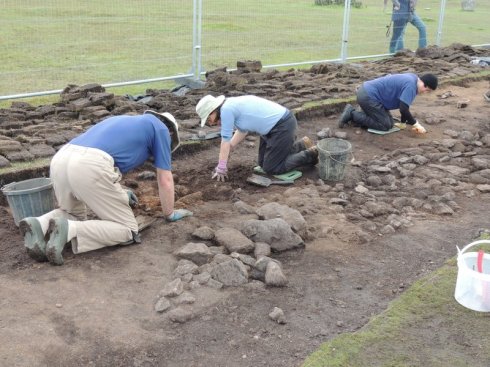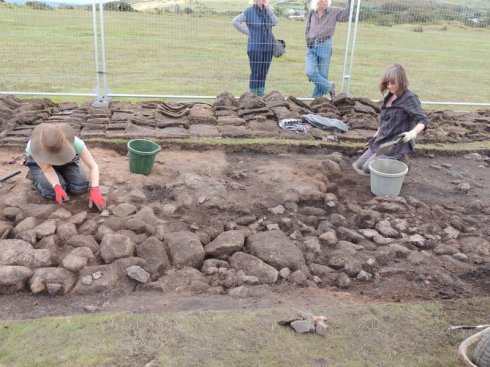Hurler’s Update: 22 September 2013 by Roy Goutté
The northern end of the pavement petering out well short of the northernmost circle
©
Roy Goutté
Finally I got to visit personally what I had been waiting months to see and take part in… the excavation at the acclaimed quartz pavement or walkway first discovered back in 1938 between the two northernmost of the three stone circles known as The Hurler’s at Minions in Cornwall. However, I was in for a couple of surprises, for once fully exposed, the pavement proved to be predominantly of locally sourced granite stones and not quartz at all. Further to that, the pavement did not extend to either circle, falling short by some 12-15ft to the southern end and some 25-30ft to the north. After speaking at length to Cornwall Historic Environment Projects archaeologist James Gossip, I felt this was not expected and has now cast doubt on its real purpose!
A mid section of pavement showing very lumpy ‘locally’ sourced granite stones and not quartz as expected
©
Roy Goutté
James is a very enthusiastic and open minded archaeologist who it is a pleasure to talk to and work alongside and always up for a challenge, something that now seems much more likely at the Hurlers because, as the following short video clip will show, the ‘pavement’ would be quite a challenge in itself to survive without turning an ankle or two if trying to walk its length.
Uncovering the pavement while James Gossip comments on the work
©
Roy Goutté
On viewing the clip (which is just a small part of a more extensive one) you will notice the red sweater draped over the closest stone to the southern end of the pavement and the distance between it and the end of said pavement. It is a purposely finished end indicated by the clean cut of the stones and just beyond it an area has been cleared exposing the original untouched surface level. Soil analysis is taking place today (23 September) with material taken for dating if available. The vid clip will show a much taller pointed upright stone set amongst the pavement stones and it is possible that a section may be removed here for further study on the day. A metre either side of the original 1938 trench was opened up this time and in quite a few places areas of ‘activity’ could be seen with different coloured soils evident amongst sections of stones which all adds to the mystery as to what exactly we have here.
The precise southern end termination of the ‘pavement’ showing the original reddish ground surface beyond it
©
Roy Goutté
I would like to thank James personally for allowing me to enter the site and film at will and to discuss things with him and also to Ann Preston-Jones, Senior Archaeologist, Historic Environment (Projects) Cornwall Council, for keeping me informed as to the various projects taking place in this area. This was my first day out after my recent health problems and I couldn’t think of a more pleasant way to spend an hour or two and to meet up with James again. Thanks James and also to my son Oliver who accompanied me on my first tentative steps out.
Roy Goutté




4 comments
Comments feed for this article
25/09/2013 at 11:36 am
Littlestone
The triangular stone (bottom and slightly right of centre in the opening frame of the video) is puzzling; it looks like it may even have stood proud of the turf. Is there any info on how deep the stone is set?
LS
LikeLike
25/09/2013 at 3:11 pm
Roy Goutte
I was thinking the same LS judging by the depth of turf that has been cut to the sides of the extended ditch. I can’t say I’d ever noticed it jutting up out of the
turf before, but then again, there are lumps of granite popping up all over the place around the circles so it would be one of many I suspect. I’ve asked James (text) to see if he can confirm the stability of the stone, i.e. is it sat on the original ground surface with the other stones or under it? I’m hoping it’s under it.
LikeLike
25/09/2013 at 10:42 pm
James Gossip
Hi Roy, plenty of detail/analysis/research to come, but I can tell you at this stage that the pointed stone did indeed project above the turf and is buried deep into the natural subsoil. The stone surface is therefore built around it. Impossible to know how deep the stone goes at the moment without dismantling the stones.
LikeLike
26/09/2013 at 9:05 am
Roy Goutte
Hi James, thank you kindly for replying and confirming that the pointed stone is indeed earth-fast and that it does project above the modern-day turf line (you made my day). Please feel free to use the Trust to pass on further results/information as and when if this would be helpful to you as this project has caught the imagination of members worldwide and would be much appreciated. Notification of upcoming digs and any help members may be able to offer you with regard to manpower would be passed on accordingly.
Cheers, Roy.
LikeLike